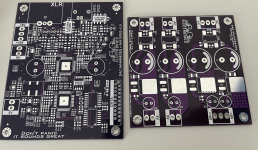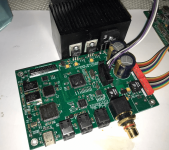Hi,
It is my second project of DAC, first was on AK4499EQ but after fire in AKM factory projest is useless. Now AK4499EQ chip is to expensive, over 1k USD in Ebay. Now afrer relese new chip on Munich AudioShow I downloaded Datasheet and started designing the new DAC on AK4499EXEQ.
DAC will be Dual Mono, one PCB DAC + Power Supply - one chanell. DAC will be working in Asynchronous mode.
Now it looks like this:

It is my second project of DAC, first was on AK4499EQ but after fire in AKM factory projest is useless. Now AK4499EQ chip is to expensive, over 1k USD in Ebay. Now afrer relese new chip on Munich AudioShow I downloaded Datasheet and started designing the new DAC on AK4499EXEQ.
DAC will be Dual Mono, one PCB DAC + Power Supply - one chanell. DAC will be working in Asynchronous mode.
Now it looks like this:
Hi,
It is my second project of DAC, first was on AK4499EQ but after fire in AKM factory projest is useless. Now AK4499EQ chip is to expensive, over 1k USD in Ebay. Now afrer relese new chip on Munich AudioShow I downloaded Datasheet and started designing the new DAC on AK4499EXEQ.
DAC will be Dual Mono, one PCB DAC + Power Supply - one chanell. DAC will be working in Asynchronous mode.
Now it looks like this:
Wow this looks great! I look forward to more on this project
Last edited:
I'm looking at a project to improve on my MiniDSP 4 way crossover. My idea is to take the I2S output bypassing the DAC and output stages of the MiniDSP so this could be interesting to me.
What specs are you expecting from the DAC and will it have I2S header?
What specs are you expecting from the DAC and will it have I2S header?
It is possible to send I2S signal directly to DAC PCB via pins header and write dedicate soft for DAC for this option. There are many solutions 🙂I'm looking at a project to improve on my MiniDSP 4 way crossover. My idea is to take the I2S output bypassing the DAC and output stages of the MiniDSP so this could be interesting to me.
DAC will be full dual mono. I2S signal form Input PCB will be send to each DAC chanell via digital isolator. One PCB DAC and one PCB Power Supply - One chanell. That was main goal.What specs are you expecting from the DAC and will it have I2S header?
DAC will have 6 imputs:
-USB
-3 x SPDIF
-2 x COAX
Very nice project, just wondering about software support and all kind of modes (PCM, DSD...).
Keep going
Keep going
Every necessery options will be possibility to change from display with buttons and encoder.Very nice project, just wondering about software support and all kind of modes (PCM, DSD...).
Keep going
Input PCB comes form previous version of DAC on AK4499EQ.
Thank You 🙂
Attachments
So you did the board also by your own, cool. So you also do the software driver or are they based on an open source project?Every necessery options will be possibility to change from display with buttons and encoder.
Input PCB comes form previous version of DAC on AK4499EQ.
Thank You 🙂
Generally I did software by my own in STM32CubeIDE but OLED library I took from from github.So you did the board also by your own, cool. So you also do the software driver or are they based on an open source project?
which opamp will you used for i/v convert stage?How about a cfa one? and it seems that ak4499ex no longer needs 4 big capacitors for the Vref inputs?
Good crystal oscillator, parts and PCB layout can do more than complex jitter system correction.what are jitter corrections systems?
OPA1612opamps, usb chip?
USB converter is my version of Amanero. Regular version has some compromises in oscillators, power supply. I use better parts and designed converter on 4 layer board.
I used OPA1612 and analog schematic comes form datasheet.which opamp will you used for i/v convert stage?How about a cfa one? and it seems that ak4499ex no longer needs 4 big capacitors for the Vref inputs?
EQ version has 4 chanell so has 4 capacitors. EX version has 2 channells.
So that is still the 4499 it is. 🙂Good crystal oscillator, parts and PCB layout can do more than complex jitter system correction.
OPA1612
USB converter is my version of Amanero. Regular version has some compromises in oscillators, power supply. I use better parts and designed converter on 4 layer board.
I used OPA1612 and analog schematic comes form datasheet.
EQ version has 4 chanell so has 4 capacitors. EX version has 2 channells.
Not quite clear what would be considered 'complex jitter system correction?' ASRC? Reclocking? Something else?Good crystal oscillator, parts and PCB layout can do more than complex jitter system correction.
Should be something more complex than already used custom made Amanero solution.Not quite clear what would be considered 'complex jitter system correction?' ASRC? Reclocking? Something else?
I agreed that will be unnessary.
DAC will be working on asynchronous mode. Using Crystek oscillator jitter is not a problem in that low frequency. I prefere to pay more attencion on other things like looks on current flow, correct placing of tej components, propper PCB layout, PCB stackup, good power supply, etc. That is my philosophy of work.
Please tell me more about jitter issue.
Please tell me more about jitter issue.
Jitter (particularly close-in phase noise) can have various effect on perceptual sound quality. Usually dacs sound better when operated in fully synchronous mode, including synchronous with the USB board. The typical way of making asynchronous mode work is to use ASRC. However, ASRC needs a type of PLL sometimes referred to as poly-phase locked loop (PPLL). It turns out that PPLL is more stable than a typical PLL, yet ASRC can at best only attenuate jitter not eliminate it. PLLs can also be sensitive to power rail noise. Such noise can cause additional jitter effects in ASRCs. Therefore synchronous mode operation can be lower jitter, at least if well implemented.
Last edited:
- Home
- Source & Line
- Digital Line Level
- DAC AK4499EX Project


